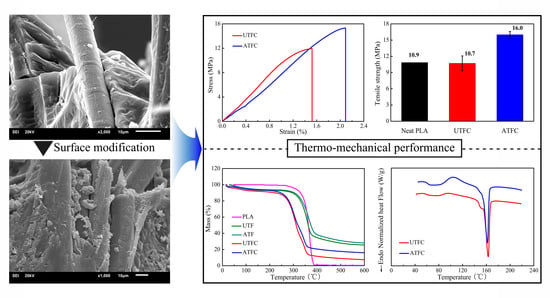Thermo-Mechanical Performance of Polylactide Composites Reinforced with Alkali-Treated Bamboo Fibers
Abstract
:1. Introduction
2. Experimental Details
2.1. Materials
2.2. Alkali Treatment
2.3. Preparation of Composite
2.4. Test Methods
2.4.1. Tensile Test
2.4.2. Scanning Electron Microscopy
2.4.3. X-ray Diffraction
2.4.4. Thermogravimetric Analysis and Its Derivative
2.4.5. Differential Scanning Calorimetry Analysis
3. Results and Discussion
3.1. Mechanical Properties
3.2. Thermal Properties
4. Conclusions
Acknowledgments
Author Contributions
Conflicts of Interest
References
- Cheung, H.Y.; Lau, K.T.; Tao, X.M.; Hui, D. A potential material for tissue engineering: Silkworm silk/PLA biocomposite. Compos. B Eng. 2008, 39, 1026–1033. [Google Scholar] [CrossRef]
- Sarasini, F.; Tirillò, J.; Puglia, D.; Kenny, J.M.; Dominici, F.; Santulli, C.; Tofani, M.; De Santis, R. Effect of different lignocellulosic fibres on poly(ε-caprolactone)-based composites for potential applications in orthotics. RSC Adv. 2015, 5, 23798–23809. [Google Scholar] [CrossRef]
- Enriquez, E.; Mohanty, A.K.; Misra, M. Alkali and peroxide bleach treatments on spring harvested switchgrass for potential composite application. Bioresources 2016, 11, 9922–9939. [Google Scholar] [CrossRef]
- Zhou, Y.H.; Fan, M.Z.; Chen, L.H. Interface and bonding mechanisms of plant fibre composites: An overview. Compos. B Eng. 2016, 101, 31–45. [Google Scholar] [CrossRef]
- Tian, X.Y.; Liu, T.F.; Yang, C.C.; Wang, Q.R.; Li, D.C. Interface and performance of 3D printed continuous carbon fiber reinforced PLA composites. Compos. A Appl. Sci. Manuf. 2016, 88, 198–205. [Google Scholar] [CrossRef]
- Panyasart, K.; Chaiyut, N.; Amornsakchai, T.; Santawitee, O. Effect of surface treatment on the properties of pineapple leaf fibers reinforced polyamide 6 composites. Energy Procedia 2014, 56, 406–413. [Google Scholar] [CrossRef]
- Maleki, L.; Edlund, U.; Albertsson, A.C. Synthesis of full interpenetrating hemicellulose hydrogel networks. Carbohydr. Polym. 2017, 170, 254–263. [Google Scholar] [CrossRef] [PubMed]
- Atifi, S.; Miao, C.W.; Hamad, W.Y. Surface modification of lignin for applications in polypropylene blends. J. Appl. Polym. Sci. 2017, 134, 45103. [Google Scholar] [CrossRef]
- Zhang, X.P.; Wang, F.; Keer, L.M. Influence of surface modification on the microstructure and thermo-mechanical properties of bamboo fibers. Materials 2015, 8, 6597–6608. [Google Scholar] [CrossRef] [PubMed]
- Wang, F.; Shao, J.X. Modified Weibull distribution for analyzing the tensile strength of bamboo fibers. Polymers 2014, 6, 3005–3018. [Google Scholar] [CrossRef]
- Wang, F.; Li, X.; Zhang, J.Q.; Li, L.; Keer, L.M. Micromechanical modelling of the progressive failure in unidirectional composites reinforced with bamboo fibres. Mech. Mater. 2016, 94, 180–192. [Google Scholar] [CrossRef]
- Abdul Khalil, H.P.S.; Bhat, I.U.H.; Jawaid, M.; Zaidon, A.; Hermawan, D.; Hadi, Y.S. Bamboo fibre reinforced biocomposites: A review. Mater. Des. 2012, 42, 353–368. [Google Scholar] [CrossRef]
- Jiang, L.Y.; Li, Y.; Xiong, C.D.; Su, S.P. Preparation and characterization of a novel degradable nano-hydroxyapatite/poly(lactic-co-glycolic) composite reinforced with bamboo fiber. Mater. Sci. Eng. C 2017, 75, 1014–1018. [Google Scholar] [CrossRef] [PubMed]
- Prasad, A.V.R.; Rao, K.M. Mechanical properties of natural fibre reinforced polyester composites: Jowar, sisal and bamboo. Mater. Des. 2011, 32, 4658–4663. [Google Scholar] [CrossRef]
- Fuentes, C.A.; Tran, L.Q.N.; Van Hellemont, M.; Janssens, V.; Dupont-Gillain, C.; Van Vuure, A.W.; Verpoest, I. Effect of physical adhesion on mechanical behaviour of bamboo fibre reinforced thermoplastic composites. Colloids Surf. A Physicochem. Eng. Aspects 2013, 418, 7–15. [Google Scholar] [CrossRef]
- Threepopnatkul, P.; Kaerkitcha, N.; Athipongarporn, N. Effect of surface treatment on performance of pineapple leaf fiber-polycarbonate composites. Compos. B Eng. 2009, 40, 628–632. [Google Scholar] [CrossRef]
- Manalo, A.C.; Wani, E.; Zukarnain, N.A.; Karunasena, W.; Lau, K.T. Effects of alkali treatment and elevated temperature on the mechanical properties of bamboo fibre-polyester composites. Compos. B Eng. 2015, 80, 73–83. [Google Scholar] [CrossRef]
- Manshor, M.R.; Anuar, H.; Aimi, M.N.N.; Fitrie, M.I.A.; Nazri, W.B.W.; Sapuan, S.M.; EI-Shekeil, Y.A.; Wahit, M.U. Mechanical, thermal and morphological properties of durian skin fibre reinforced PLA biocomposites. Mater. Des. 2014, 59, 279–286. [Google Scholar] [CrossRef]
- Wang, F.; Zhou, S.J.; Li, L.; Zhang, X.P. Changes in the morphological-mechanical properties and thermal stability of bamboo fibers during the processing of alkaline treatment. Polym. Compos. 2017. [Google Scholar] [CrossRef]
- Qian, S.P.; Mao, H.L.; Sheng, K.C.; Lu, J.; Luo, Y.F.; Hou, C.Y. Effect of low-concentration alkali solution pretreatment on the properties of bamboo particles reinforced poly(lactic acid) composites. J. Appl. Polym. Sci. 2013, 130, 1667–1674. [Google Scholar] [CrossRef]
- Standard Test Method for Tensile Properties of Plastics; ASTM International: West Conshohocken, PA, USA, 2010; ASTM D638-10.
- Gomes, A.; Matsuo, T.; Goda, K.; Ohgi, J. Development and effect of alkali treatment on tensile properties of curaua fiber green composites. Compos. A Appl. Sci. Manuf. 2007, 38, 1811–1820. [Google Scholar] [CrossRef]
- Yue, Y.Y.; Zhou, C.J.; French, A.D.; Xia, G.; Han, G.P.; Wang, Q.W.; Wu, Q.L. Comparative properties of cellulose nano-crystals from native and mercerized cotton fibers. Cellulose 2012, 19, 1173–1187. [Google Scholar] [CrossRef]
- Naikwade, M.; Liu, F.; Wen, S.; Cai, Y.J.; Navik, R. Combined use of cationization and mercerization as pretreatment for the deep dyeing of ramie fibre. Fibers Polym. 2017, 18, 1734–1740. [Google Scholar] [CrossRef]
- Wang, F.; Shao, J.X.; Keer, L.M.; Li, L.; Zhang, J.Q. The effect of elementary fibre variability on bamboo fibre strength. Mater. Des. 2015, 75, 136–142. [Google Scholar] [CrossRef]
- Lu, T.J.; Jiang, M.; Jiang, Z.G.; Hui, D.; Wang, Z.Y.; Zhou, Z.W. Effect of surface modification of bamboo cellulose fibers on mechanical properties of cellulose/epoxy composites. Compos. B Eng. 2013, 51, 28–34. [Google Scholar] [CrossRef]
- Sinha, E.; Rout, S.K. Influence of fibre-surface treatment on structural, thermal and mechanical properties of jute fibre and its composite. Bull. Mater. Sci. 2009, 32, 65–76. [Google Scholar] [CrossRef]
- Sathishkumar, T.P.; Navaneethakrishnan, P.; Shankar, S.; Rajasekar, R.; Rajini, N. Characterization of natural fiber and composites—A review. J. Reinf. Plast. Compos. 2013, 32, 1457–1476. [Google Scholar] [CrossRef]
- Lopattananon, N.; Payae, Y.; Seadan, M. Influence of fiber modification on interfacial adhesion and mechanical properties of pineapple leaf fiber-epoxy composites. J. Appl. Polym. Sci. 2008, 110, 433–443. [Google Scholar] [CrossRef]
- Yan, L.B.; Chouw, N.; Huang, L.; Kasal, B. Effect of alkali treatment on microstructure and mechanical properties of coir fibres, coir fibre reinforced-polymer composites and reinforced-cementitious composites. Constr. Build. Mater. 2016, 112, 168–182. [Google Scholar] [CrossRef]
- Kabir, M.M.; Wang, H.; Lau, K.T.; Cardona, F. Tensile properties of chemically treated hemp fibres as reinforcement for composites. Compos. B Eng. 2013, 53, 362–368. [Google Scholar] [CrossRef]
- Sarasini, F.; Tirillò, J.; Puglia, D.; Dominici, F.; Santulli, C.; Boimau, K.; Valente, T.; Torre, L. Biodegradable polycaprolactone-based composites reinforced with ramie and borassus fibres. Compos. Struct. 2017, 167, 20–29. [Google Scholar] [CrossRef]
- Cai, M.; Takagi, H.; Nakagaito, A.N.; Katoh, M.; Ueki, T.; Waterhouse, G.I.N.; Li, Y. Influence of alkali treatment on internal microstructure and tensile properties of abaca fibers. Ind. Crop. Prod. 2015, 65, 27–35. [Google Scholar] [CrossRef]
- Suryanegara, L.; Nakagaito, A.N.; Yano, H. The effect of crystallization of PLA on the thermal and mechanical properties of microfibrillated cellulose-reinforced PLA composites. Compos. Sci. Technol. 2009, 69, 1187–1192. [Google Scholar] [CrossRef]
- Son, Y.N.; Tashiro, K.; Xu, D.G.; Liu, J.; Bin, Y.Z. Crystallization behavior of poly(lactic acid)/microfibrillated cellulose composite. Polymer 2013, 54, 3417–3425. [Google Scholar] [CrossRef]
- Huda, M.S.; Drzal, L.T.; Mohanty, A.K.; Misra, M. Effect of fiber surface-treatments on the properties of laminated biocomposites from poly(lactic acid) (PLA) and kenaf fibers. Compos. Sci. Technol. 2008, 68, 424–432. [Google Scholar] [CrossRef]
- Islam, M.S.; Pickering, K.L.; Foreman, N.J. Influence of alkali treatment on the interfacial and physico-mechanical properties of industrial hemp fibre reinforced polylactic acid composites. Compos. A Appl. Sci. Manuf. 2010, 41, 596–603. [Google Scholar] [CrossRef]
- Dos Santos, F.A.; Iulianelli, G.C.V.; Tavares, M.I.B. Development and properties evaluation of bio-based PLA/PLGA blend films reinforced with microcrystalline cellulose and organophilic silica. Polym. Eng. Sci. 2017, 57, 464–472. [Google Scholar] [CrossRef]
- Chen, Y.A.; Chen, E.C.; Wu, T.M. Lamellae evolution of stereocomplex-type poly(lactic acid)/organically-modified layered zinc phenylphosphonate nanocomposites induced by isothermal crystallization. Materials 2016, 9, 159. [Google Scholar] [CrossRef] [PubMed]
- Posada, J.C.; Jaramillo, L.Y.; Cadena, E.M.; Garcia, L.A. Bio-based composites from agricultural wastes: Polylactic acid and bamboo Guadua angustifolia. J. Compos. Mater. 2016, 50, 3229–3237. [Google Scholar] [CrossRef]
- Nam, T.H.; Ogihara, S.; Nakatani, H.; Kobayashi, S.; Song, J.I. Mechanical and thermal properties and water absorption of jute fiber reinforced poly(butylene succinate) biodegradable composites. Adv. Compos. Mater. 2012, 21, 241–258. [Google Scholar] [CrossRef]
- Lee, S.H.; Wang, S.Q. Biodegradable polymers/bamboo fiber biocomposite with bio-based coupling agent. Compos. A Appl. Sci. Manuf. 2006, 37, 80–91. [Google Scholar] [CrossRef]
- George, J.; Bhagawan, S.S.; Thomas, S. Thermogravimetric and dynamic mechanical thermal analysis of pineapple fibre reinforced polyethylene composites. J. Therm. Anal. 1996, 47, 1121–1140. [Google Scholar] [CrossRef]
- Joseph, S.; Sreekala, M.S.; Thomas, S. Effect of chemical modifications on the thermal stability and degradation of banana fiber and banana fiber-reinforced phenol formaldehyde composites. J. Appl. Polym. Sci. 2008, 110, 2305–2314. [Google Scholar] [CrossRef]
- Auras, R.; Harte, B.; Selke, S. An overview of polylactides as packing materials. Macromol. Biosci. 2004, 4, 835–864. [Google Scholar] [CrossRef] [PubMed]
- Pan, P.; Kai, W.; Zhu, B.; Dong, T.; Inoue, Y. Polymorphous crystallization and multiple melting behavior of poly(l-lactide): Molecular weight dependence. Macromolecules 2007, 40, 6898–6905. [Google Scholar] [CrossRef]
- Li, X.; Wang, F. Effect of the statistical nature of fiber strength on the predictability of tensile properties of polymer composites reinforced with bamboo fibers: Comparison of Linear- and Power-law Weibull models. Polymers 2016, 8, 24. [Google Scholar] [CrossRef]

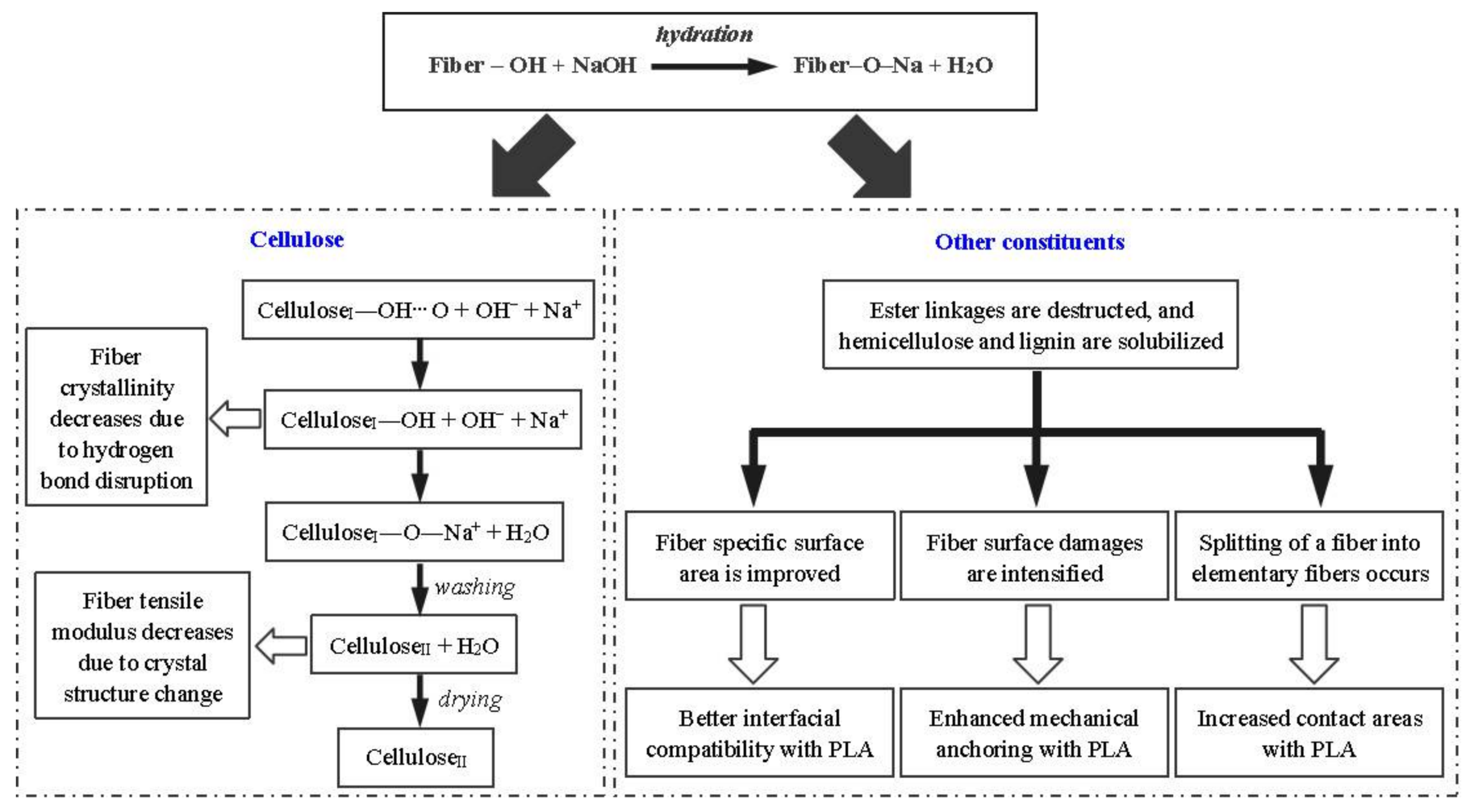
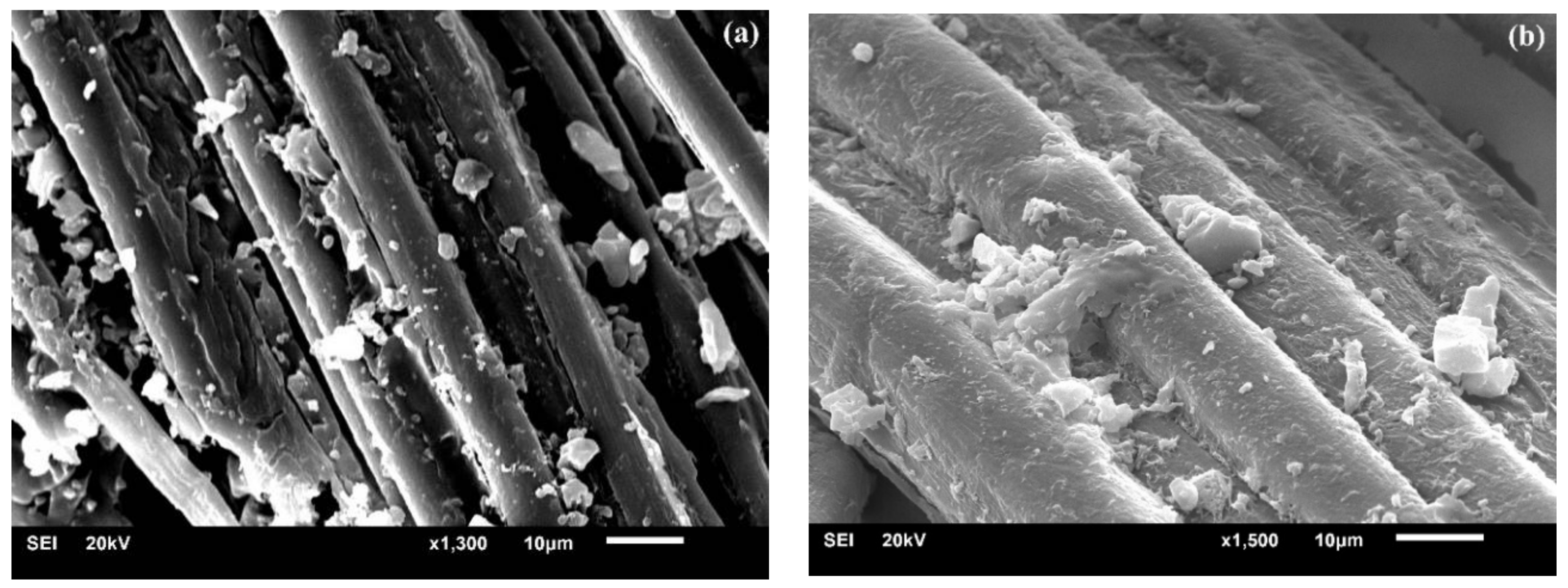

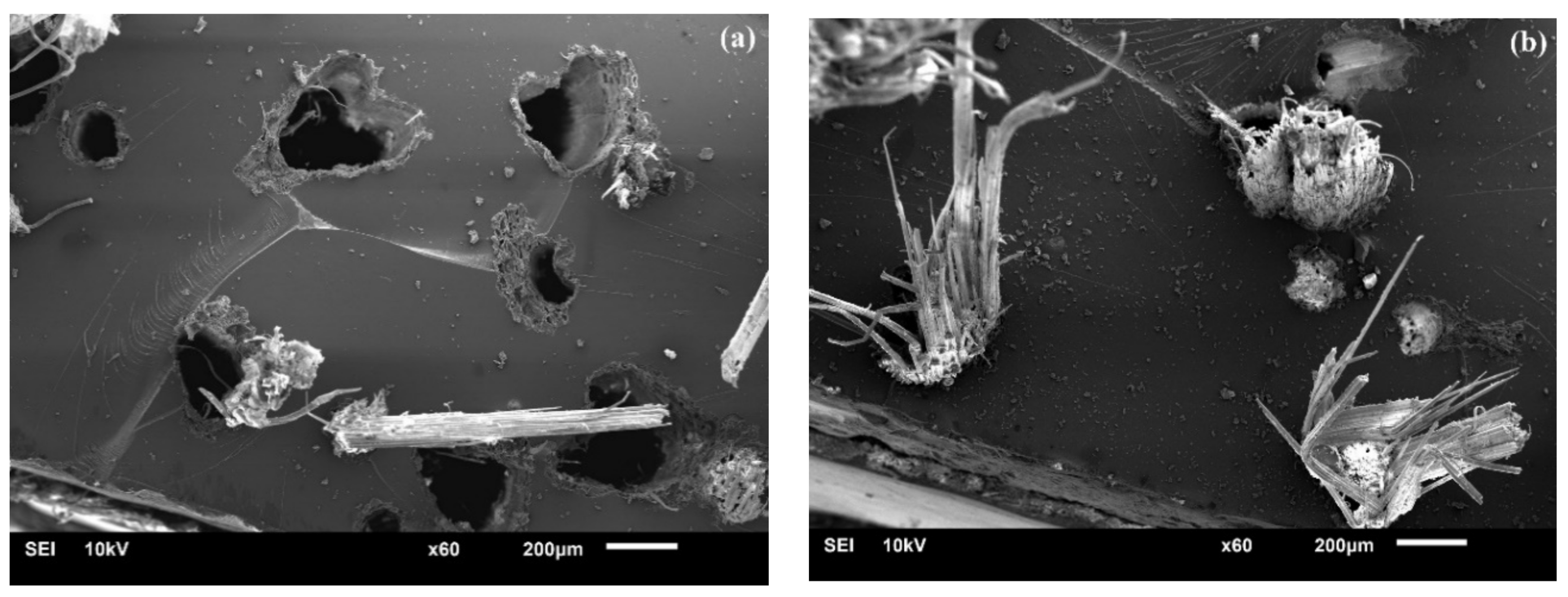
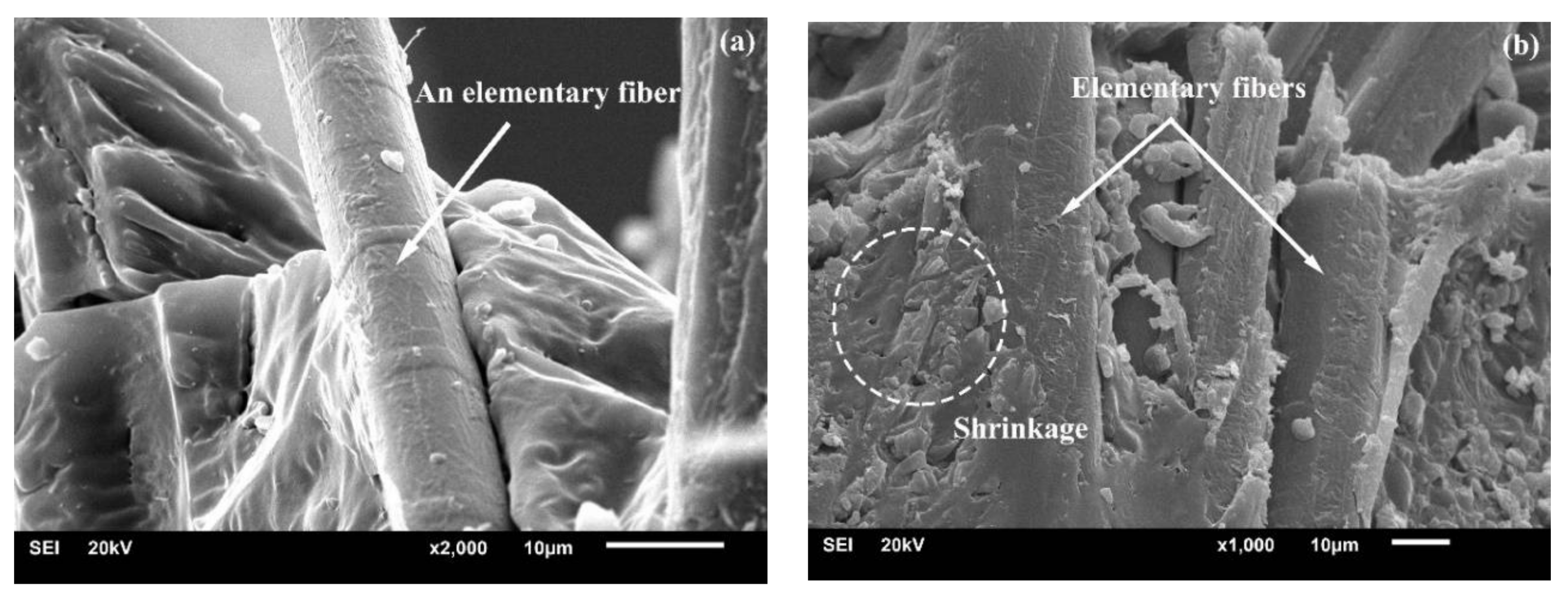
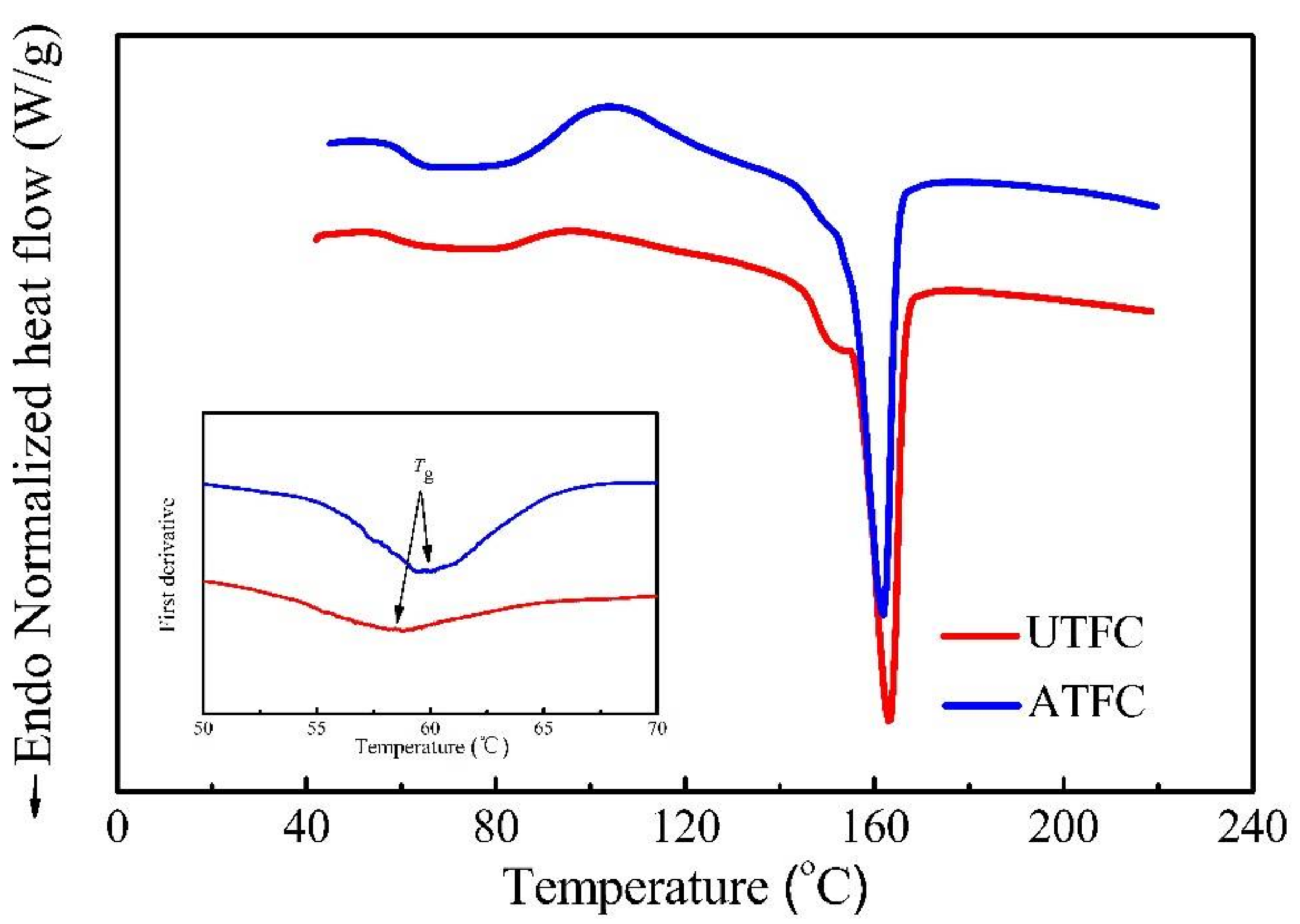


| Mn (kg/mol) | MW (kg/mol) | MW/Mn | Tg (°C) | Tcc (°C) | Tm (°C) | L/D | Diameter (μm) | ρm (g/cm3) | Tensile Strength (MPa) | Tensile Modulus (MPa) | Elongation at Breaks (%) |
|---|---|---|---|---|---|---|---|---|---|---|---|
| 23.5 | 40 | 1.7 | 48.0 | 83.2 | 159.6 | 98:2 | 12.64 | 1.26 | 10.9 | 411.5 | 5.2 |
| Performance | Average Value for UTFC | Average Value for ATFC | p Value (t-Test) for UTFC and ATFC (α = 0.05) | Significant Difference |
|---|---|---|---|---|
| Tensile strength (MPa) | 10.7 ± 1.37 | 16.0 ± 0.60 | 0.004 | Yes |
| Elongation at break (%) | 1.3 ± 0.15 | 2.4 ± 0.24 | 0.003 | Yes |
| Tensile modulus (MPa) | 745.8 ± 70.33 | 586.8 ± 23.89 | 0.021 | Yes |
| Performance | Average Value for UTF | Average Value for ATF | p Value (t-Test) for UTF and ATF (α = 0.05) | Significant Difference |
|---|---|---|---|---|
| Xc (%) | 43.5 ± 1.04 | 35.7 ± 2.81 | 0.011 | Yes |
| Performance | Average Value for UTFC | Average Value for ATFC | p Value (t-Test) for UTFC and ATFC (α = 0.05) | Significant Difference |
|---|---|---|---|---|
| Tg (°C) | 57.3 ± 1.5 | 59.9 ± 0.7 | 0.048 | Yes |
| Tcc (°C) | 93.7 ± 1.9 | 104.8 ± 1.6 | 0.002 | Yes |
| Tm (°C) | 161.9 ± 1.3 | 154.4 ± 3.4 | 0.025 | Yes |
| ΔHcc (J/g) | 3.4 ± 2.0 | 9.6 ± 2.3 | 0.025 | Yes |
| ΔHm (J/g) | 19.3 ± 2.3 | 16.0 ± 2.0 | 0.133 | No |
| Xc (%) | 21.2 ± 1.4 | 9.7 ± 2.5 | 0.002 | Yes |
| Performance | Average Value for UTFC | Average Value for ATFC | p Value (t-Test) for UTFC and ATFC (α = 0.05) | Significant Difference | |
|---|---|---|---|---|---|
| Peak temperatures (°C) | I | 75.7 ± 1.4 | 73.7 ± 2.1 | 0.252 | No |
| II | 302.1 ± 2.5 | 292.4 ± 5.3 | 0.045 | Yes | |
| III | 357.6 ± 2.7 | 346.5 ± 1.0 | 0.002 | Yes | |
| Weight loss (%) | I | 5.3 ± 0.5 | 3.2 ± 1.1 | 0.038 | Yes |
| II | 44.2 ± 1.3 | 34.4 ± 3.1 | 0.007 | Yes | |
| III | 76.3 ± 1.1 | 68.1 ± 1.0 | 0.001 | Yes | |
© 2018 by the authors. Licensee MDPI, Basel, Switzerland. This article is an open access article distributed under the terms and conditions of the Creative Commons Attribution (CC BY) license (http://creativecommons.org/licenses/by/4.0/).
Share and Cite
Wang, F.; Zhou, S.; Yang, M.; Chen, Z.; Ran, S. Thermo-Mechanical Performance of Polylactide Composites Reinforced with Alkali-Treated Bamboo Fibers. Polymers 2018, 10, 401. https://doi.org/10.3390/polym10040401
Wang F, Zhou S, Yang M, Chen Z, Ran S. Thermo-Mechanical Performance of Polylactide Composites Reinforced with Alkali-Treated Bamboo Fibers. Polymers. 2018; 10(4):401. https://doi.org/10.3390/polym10040401
Chicago/Turabian StyleWang, Fang, Shujue Zhou, Mengqing Yang, Zhiqian Chen, and Siyan Ran. 2018. "Thermo-Mechanical Performance of Polylactide Composites Reinforced with Alkali-Treated Bamboo Fibers" Polymers 10, no. 4: 401. https://doi.org/10.3390/polym10040401




